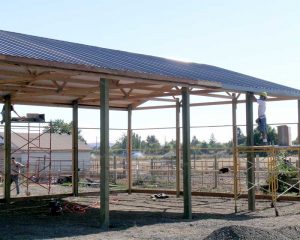
I recently spoke with a prospective client in California. This particular gentleman is an electrical contractor, and fancies himself as being fairly handy. He is considering doing the construction of his new pole building kit himself, however was terrified by the prospect of having to set the building columns.
Being honest, we all have our fears and phobias. One of the most interesting ones I encounter frequently with clients (such as our friend above) is “postsetaphobia”, or fear of setting posts. This particular phobia is defined as, “the fear of being able to properly set posts for a pole building”.
Fear is False Evidence Appearing Real.
99% of all fear is not justified and is not “real” unless one focuses on it and attracts it.
Examining the realities of the situation….most pole building foundation systems are based upon rectangular or square sawn pressure treated timbers, embedded into holes augered into the ground. Sounds scary when defined like this, isn’t it?
Setting posts is really very easy!
These augered holes are going to range from an 18 inch diameter on a very small building, to 24, 30 or even 36 inch diameters on a large structure. Assuming a very small building, the columns will probably be 4×6. Now a 4×6 actually measures 3-1/2” x 5-1/2” (topic for a future blog posting), or 6-1/2 inches across the diagonal. Even with the least hole diameter of 18 inches, this leaves almost a foot of “slop” to play with!
So, what is the worst thing which can happen so far? A hole is drilled a few inches off center and the very small “peg” gets shifted in a very large round hole. By moving the posts back and forth at the top of the hole, the columns can be shifted as needed to end up in a straight line.
How hard is it to obtain “plumb” when setting posts?
But, “what if I cannot get them plumb” (straight up and down)? By adjusting the braces, which temporarily support the columns prior to concrete being poured, the tops of the poles can be moved to being fairly plumb quite easily. While the ideal scenario is to have the tops of the columns leaning slightly outward, pole buildings are amazingly forgiving and the tops of the poles can be adjusted laterally by even several inches later in the construction process.
Over the course of 30 years most of the pole buildings I’ve sold have been constructed by homeowners with no building experience whatsoever. I have yet to have someone who has voiced this setting posts concern to call me later and say “It was a nightmare”. Instead, I’ve had countless folks tell me, “Wow, it really wasn’t so bad after all”. Like many fears, this is one in which the anticipation of the event, is far worse than the real thing.






